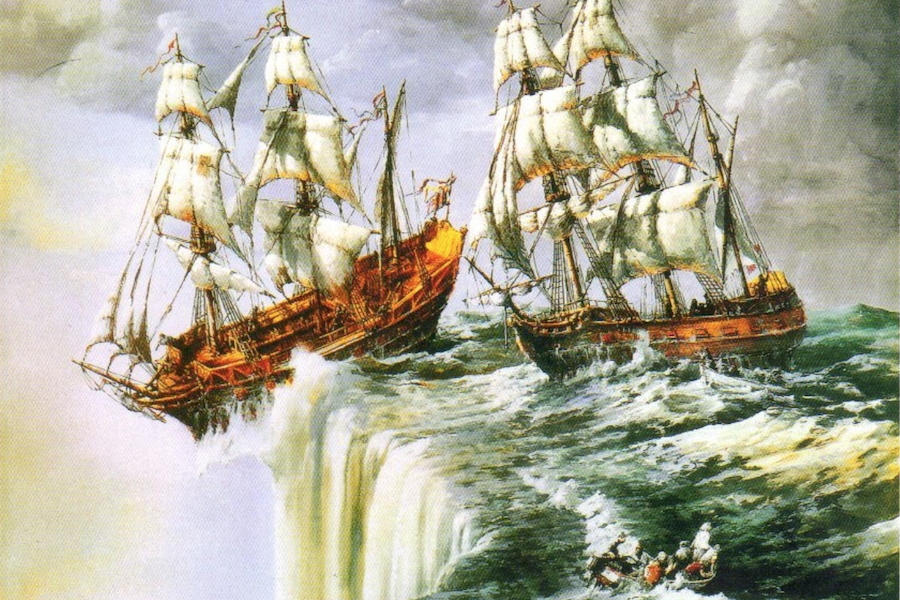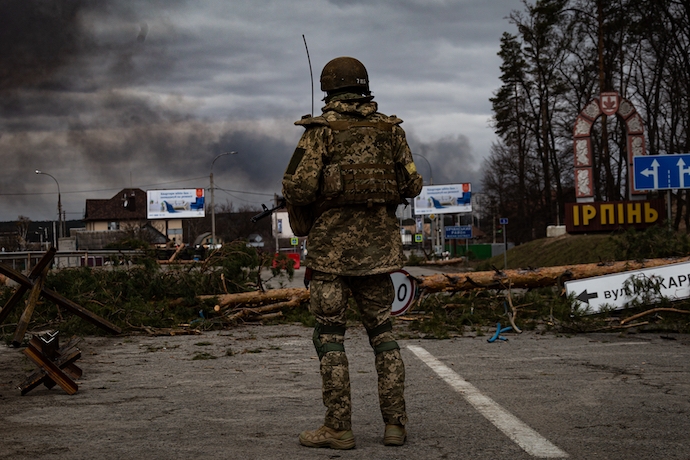
Friedman’s ‘The World is Flat’ Hasn’t Aged Well
Back in 2005, The World is Flat, Thomas Friedman’s best-seller, prophesied if not promised a globally integrated, and what he called, a flat and frictionless world economy. The winners would be those who fully embraced such a future, the losers would be those outside who resisted it. From the vantage point of 2005, the world did look flat and the future frictionless. But from the commanding heights of 2022, in a world marked by a global pandemic and the Russian invasion of Ukraine, such a picture looks less likely, with the world looking increasingly bumpy and less integrated, at least along the lines envisioned by Friedman.
The thesis is that the pandemic and the war in Ukraine are only one of several challenges to a globalized world that have been emerging in the years since Friedman penned his bestseller and that even after we emerge from the pandemic at some point there are many dangers that continue to threaten a global vision of the world. In effect, for the near future, the world appears to be bumpy and rift with friction.
The Multipolar, Bipolar and Unipolar Worlds
On one level, the story of globalization is the tale of human history. From the day humans left Africa and migrated across the world, globalization began. Yet the modern story starts after the Second World War.
Post-Second World War, it was the Cold War division that created the bipolar world divided between the U.S. and democratic capitalist states from authoritarian communist states, leaving a few remaining unaligned ones. Yet the very words of the era, East versus West, First World versus Second World, North versus South, Aligned versus Unaligned, all pointed to the bipolar world we lived in.
But of all that came to a crash in 1989 with the fall of the Berlin Wall and then the breakup of the Soviet Union in 1991. Writers such as Francis Fukuyama in his 1992 The End of History and the Last Man proclaimed the end of history and the victory of Western democratic capitalism. We won, they lost, the world was unipolar headed by the victorious United States.
The 1990s and the early part of the twentieth century was an era of globalization and integration. The 1994 North American Free Trade Agreement was one of many conventions that sought to integrate the global economy. The founding of the World Trade Organization in 1995 and the coming of age of the 1947 General Agreement on Tariffs and Trade (GATT) worked to bring down trade barriers. In Europe, the maturing of the European Union with the Maastricht Treaty (1992), Lisbon Treaty (2007), and the expansion of membership at its peak to twenty-eight member states all were clear proof of a globalized world.

Enter Friedman’s Flat World
It is at the juncture at the beginning of the twenty-first century that Friedman’s The World is Flat makes its first appearance.
Friedman saw globalization as having gone through three stages that have metaphorically reduced the world from large to small. Version 1.0 (1492-1800) shrank the world from large to medium. The agent of change was brawn, and it was about countries and muscles.
Version 2.0 (1800-2000) shrank the world from medium to small. It was directed by multinational corporations going global for markets and labor. It was at first driven by falling transportation costs, then the telecommunications revolution, and then the Internet. Version 3.0 (2000- present) shrinks the world even smaller and flattens the playing field. It is directed by individuals seeking to collaborate and compete globally and it is made possible by software and fiber optic networks.
Globalization version 3.0 is driven by what Friedman calls ten flatteners, such as the fall of the Berlin Wall, open-sourcing, out-shoring, supply-chaining, insourcing, and the creation of Microsoft Windows, and Google. These ten flatteners were subject to three convergences. Convergence one is the “complementary convergence of the ten flatteners, creating this new global playing field for multiple forms of collaboration.” Convergence two is the rise of business schools, IT specialists, CEOs, and workers comfortable with and able to develop horizontal collaborations who developed “business practices and skills that would get the most out of the flat world.” Convergence three is the introduction of new players—three billion—into a new playing field with new processes and horizons for collaboration. Overall, the ten flatteners and three convergences were yielding a frictionless flat world.
From a heady vantage point of 2005, Friedman looked correct, much like Fukuyama seemed prescient a few years earlier. Noble Prize Winner and New York Times columnist Paul Krugman among others were beside themselves in proclaiming the virtues of NAFTA and world trade. They dismissed cranks such as Ross Perot who earlier in his 1992 run for the presidency warned that the “giant sucking sound” of free trade would take jobs away from many Americans, or that the benefits would disproportionally fall to a few, and the burdens to others.
Disrupters of the Global Vision
Despite the rosy picture painted by Friedman, there were early signs that the flat world was not necessarily the future. The ascension of Russian President Vladimir Putin in 2000 and the terrorist attacks first in the United States on September 11, 2001, and then subsequent ones in Spain and Great Britain among others were another sign that open borders might need to give way to security concerns.
Since then, it has become increasingly clear that the future is not necessarily flat. If history hitherto fore was marked by patterns of convergence and divergence, as we move into the third decade of the twenty-first century, the brief history that Friedman proclaimed for this century may now be marked by the world becoming bumpy. If Friedman sees flatteners and convergence, there are several disrupters challenging the global vision.

What are these disrupters?
The 2008 Global Financial Crisis. The rapidity of the crash as it spread from the U.S. revealed the limits and problems of economic integration. The problem started with the mortgage lending markets in the U.S. where banks had every incentive to offer home loans but little incentive to ensure the loans were actually good and made to creditworthy individuals. Banks made the loans, often with little credit checks as was the case with New Century Financial, and then bundled them up and sold them on the secondary loan markets, with foreign banks, such as those in China or in Europe, buying these portfolios. When margins were called in 2008, and institutions such as Bear Sterns lacked the capital to honor them, it triggered a global financial panic that brought down the “too big to fail” in the U.S. and brought on the Great Recession across the world.
2011 Syrian refugee crisis. The 2011 Syrian civil war was only the first of several conflicts that triggered a demand to close borders. The 2021 efforts by Belarus to use refugees as weapons against Lithuania and Poland played upon fears of a new refugee crisis. In the U.S., Donald Trump successfully ran for president in 2016 on fears of an invasion of refugees from the South and Latin America, proclaiming them as rapists and murderers.
Rising nationalism. The Great Recession of 2008, as well as the 2011 refugee crisis, helped flame a new nationalism across the world. Free trade agreements and open borders made it look like conventions such as the European Union were simply an open invitation for a country to be flooded with others, potentially damaging the ethnic or racial mix of the current population. Marine Le Pen in France and Viktor Orbán in Hungary were but two examples of how rising nationalism fueled new political movements in those countries. Trumpism in the U.S., resulting in the Muslim travel ban, demands to build the border wall, and policies of asylum while you wait outside the U.S., were examples of this.
New Economic Nationalism. Trump’s “Make America Great” was not simply the product of a personality. Trump was the product of a convergence of many forces, some racial, but many economic that had been brewing for many years. Free trade and automation may have made some Americans very wealthy, but the burdens as noted above fell heavily upon the working class. In the 1990s, ivory-tower economists such as Paul Krugman cheerleaded NAFTA and free trade, but not until it became obvious that we were not all winners did he and a few others concede that perhaps they missed something in the chalkboard models. The public was never and is still not as enthusiastic and sold on free trade as tenured professors are.
Brexit. Arguably on one level the British vote in 2016 to leave the European Union and then the actual departure at the end of 2020 is one of the clearest signs of a world becoming bumpy and less frictionless. Brexit is built on the economic and racial anxieties discussed above as well as nationalism. The geography and demographics of the vote reflected clear patterns across the UK in terms of perceptions of where and who was losing and winning in the EU membership.
Geopolitics. Even before the Russian invasion of Ukraine it looks less and less like the end of history has arrived and America has won.
In Russia one finds Putin lamenting the breakup of the USSR as the greatest geopolitical disaster of the 20th century and he appears bent on re-establishing the lost empire. The Eurasian Economic Union, unification or cooperation agreements with Belarus and the invasion of Ukraine to force it within its sphere of influence demonstrate Russia remains a major player. In fact, the 2022 Russian invasion represents perhaps the most abrupt proof that globalization is both alive and dead.
China too is testing U.S. global dominance. The Belt and Road Initiative is its effort to expand its global economic influence. Its growing military confidence in the Pacific, the repression of self-rule in Hong Kong, and impatience with Taiwan’s independence and desires to resolve unification soon demonstrate the challenge to U.S. supremacy. Moreover, under Donald Trump, across the world, many countries questioned the U.S. willingness and resolve to organizations such as NATO. Even after the Russian invasion, many still question American resolve, especially after Afghanistan.
Climate change. If ever there was a challenge that demanded a concerted global response it is climate change and the warming of the Earth. While there have been several efforts at the international level to address environmental issues, including most recently the 2015 Paris Agreement, and the 2021 COP26 agreement, little progress has actually been made to slow climate change. The U.S. and China remain the biggest polluters but have little incentive to change. It is within the interest of Brazil to continue to deforest the Amazon even though doing so speeds up the warming of the planet. Climate change is opening up new frontiers of conflict.
Big Tech pushback. Friedman’s The World is Flat championed the likes of Google as levelers in the new frictionless world. They were among the forces of convergence. More than 15 years later, Google, Microsoft, and now the rise of the social media with Facebook look less as friendly integrators but more as disrupters. The global dominance of Big Tech is seen as a threat in many ways. Big Tech and especially the social media giants are seen as causes of conflict and polarization, especially as stories of how Facebook’s algorithms seem to encourage hate speech and fake news.
The pandemic. If any event has torn apart the fabric of the frictionless unipolar world it has been the emergence of the pandemic beginning in 2019. Nearly from its start, it has led to the closing of borders, interruptions in migration, the closing, opening, and reclosing of businesses and economies, and even conspiracy theories regarding the origin of the pandemic. Trump’s effort to label the pandemic as the “China virus” revealed the merger of nationalism, ethnic rivalry, and racism attached to the fears of the origins and spread of the virus.
Supply chain problems. A tenth disrupter has been the resulting supply chain problems accompanying the pandemic. In the initial stages of the pandemic, countries hoarded medical supplies such as face masks. Stories of ships carrying them being recalled ran wild as either urban legends or true. What the U.S. experienced, along with many other countries, were problems in supply chains, as often raw materials or necessary components or parts were stuck on ships or in distant ports offshore.
Businesses, seeing the problems of depending on offshore supply chains, are rethinking plant location. In late 2021, Samsung announced the construction of a new $17 billion facility outside of Austin, Texas so that it would not be cut short in the chips it needs for its cellphones and other devices. Other businesses may follow suit. Countries too may also feel that they can no longer depend on other states to make other critical goods such as medical supplies. The pandemic will force a rethinking of the value of spreading operations across the globe.
***
Several events since the publication of The World is Flat question the flat, frictionless integrated, and perhaps unipolar world that seemed inevitable then. In the last 17 years, several disrupters have made the world bumpier, with many left wondering if a planet with more friction would be more desirable, or at least more likely. Today, the future of the next part of the twenty-first century looks less like what Friedman envisioned and more like a refutation of his prophecy.

